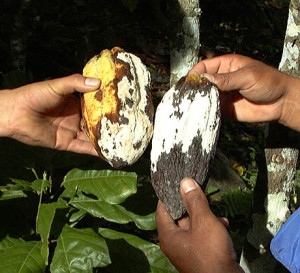
Hate to be the bearer of bitter news, but chocolate lovers…we have a problem. The world is facing an impending cocoa shortage, perhaps as soon as the year 2020. In a best case scenario, expect to see dramatically higher chocolate prices. And in the worst case <gulp>, a worldwide cocoa shortage that will make America’s favorite flavor a scarce commodity.
There are a number of reasons for the problem at hand. First, the cacao tree, the source of all chocolate, is under attack. Africa produces 70% of the world’s cocoa, and they have been devastated by a terrible drought, in addition to social and political unrest.
One thing working in our favor is that Africa’s cocoa trees have yet to be infected with diseases that plague other countries’ production such as Ecuador and other South American cocoa-producing regions. But it may be just a matter of time until diseases with names like Witches’ Broom and Frosty Pod find their way into Africa. If and when that happens, the effects could be devastating for the chocolate industry.
Cocoa is a difficult plant to grow because it is labor and time intensive. In some countries, there is a labor shortage of workers able to tend to the crop.
The problem is compounded by the dramatic increase in chocolate consumption in areas like China and India, where chocolate is still a relatively new pleasure. So what we’re seeing is much more demand and much less supply than ever before. Not good.
But there are reasons to not lose hope. Scientists have been working toward a solution to increase cocoa production. In Ecuador, a man named Homer Castro worked for several years cross-breeding different cocoa trees to develop a super tree that is resistant to disease.
On his 51st try, Castro grew a new plant, which he named Coleccion Castro Naranjal or simply CCN-51. These trees have been producing 10 times the amount of cacao beans as normal trees, and have been proven resistant to Witches’ Broom.
There is one problem. The taste of CCN is reminiscent of rusty nails, not exactly what we want our chocolate to taste like. However, experimentation with fermenting the beans in burlap sacks, and increased sun exposure have vastly improved the taste in studies. Other work is also underway to improve growing and production techniques to combat the mounting threats.
As you enjoy your chocolate today, whether it be a handful of chocolate coins, a delicious 72% single-origin dark bar, or a warm homemade chocolate chip cookie, savor each moment. Chocolate may become more of a rare treat than a go-to indulgence before long.
Not to scare you, but chocolate lovers…we have a problem. The world is facing an impending cocoa shortage, perhaps as soon as the year 2020. In a best case scenario, expect to see dramatically higher chocolate prices. And in the worst case <gulp>, a worldwide cocoa shortage that will make America’s favorite flavor a scarce commodity.
There are a number of reasons for the problem at hand. First, the cacao tree, the source of all chocolate, is under attack. Africa produces 70% of the world’s cocoa, and they have been devastated by a terrible drought, in addition to social and political unrest.

One thing working in our favor is that Africa’s cocoa trees have yet to be infected with diseases that plague other countries’ production such as Ecuador and Indonesia. But it may be just a matter of time until diseases with names like Witches’ Broom and Frosty Pod find their way into Africa. If and when that happens, the effects could be devastating for the chocolate industry.
Cocoa is a difficult plant to grow because it is labor and time intensive. In some countries, there is a labor shortage of workers able to tend to the crop.
The problem is compounded by the dramatic increase in chocolate consumption in areas like China and India, where chocolate is still a relatively new pleasure. So what we’re we’re seeing is much more demand and much less supply than ever before. Not good.
But there are reasons to not lose hope. Scientists have been working toward a solution to increase cocoa production. In Ecuador, a man named Homer Castro worked for several years cross-breeding different cocoa trees to develop a super tree that is resistant to disease.
On his 51st try, Castro grew a new plant, which he named Coleccion Castro Naranjal or simply CCN-51. These trees have been producing 10 times the amount of cacao beans as normal trees, and have been proven resistant to Witches’ Broom.
There is one problem. The taste of CCN is reminiscent of rusty nails, not exactly what we want our chocolate to taste like. However, experimentation with fermenting the beans in burlap sacks, and increased sun exposure have vastly improved the taste in studies. Other work is also underway to improve growing and production techniques to combat the mounting threats.
As you enjoy your chocolate today, whether it be a handful of chocolate coins, a delicious 72% single-origin dark bar, or a warm homemade chocolate chip cookie, savor each moment. Chocolate may become more of a rare treat than a go-to indulgence before long.